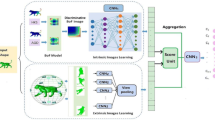Abstract
Recently Poggio and Edelman have shown that for each object there exists a smooth mapping from an arbitrary view to its standard view and that the mapping can be learned from a sparse data set. In this paper, we extend their scheme further to deal with 3D flexible objects. We show the mappings from an arbitrary view to the standard view, and its rotated view can be synthesized even for a flexible object by learning from examples. To classify 3D flexible objects, we propose two methods, which do not require any special knowledge on the target flexible objects. They are: (1) learning the characteristic function of the object and (2) learning the view-change transformation. We show their performance by computer simulations.
Similar content being viewed by others
References
Basri R (1990) The recognition of 3D solid objects from 2D images. PhD Thesis, Weizmann Institute of Science, Rehovot, Israel
Bolle R, et al (1984) 3DPO: a three-dimensional part orientation system. Proceedings of the 1st International Symposium on Robotics Research. MIT Press, Cambridge, Mass, pp 413–424
Brooks R (1984) Symbolic reasoning among 3-D models and 2-D images. Artif Intell 17:285–348
Brunelli R, Poggio T (1991) Hyper BF networks for real object recognition. Proceedings, IJCAI-91, pp 1278–1284
Koenderink JJ, Doom AJ van (1979) The internal representation of solid shape with respect to vision. Biol Cybern 32:211–216
Maruyama M, Girosi F, Poggio T (1991) Techniques for learning from examples: numerical comparisons and approximation power. MIT AI Laboratory Memo 1290
Poggio T (1991) 3D object recognition and prototypes: one 2D view may be sufficient. Technical Report 9107–02, IRST, Italy
Poggio T, Edelman S (1990) A network that learns to recognize 3D objects. Nature 343:263–266
Poggio T, Girosi F (1990) Networks for approximation and learning. roc IEEE 78:1481–1497
Press WH et al (1987) Numerical recipes in C. Cambridge University Press, Cambridge, UK
Ullman S, Basri R (1991) Recognition by linear combinations of models. IEEE Trans Pattern Anal Machine Intell 13:992–1006
Author information
Authors and Affiliations
Rights and permissions
About this article
Cite this article
Maruyama, M., Teraoka, T. & Abe, S. Recognition of 3D flexible objects by GRBF. Biol. Cybern. 70, 377–385 (1994). https://doi.org/10.1007/BF00200335
Received:
Accepted:
Issue Date:
DOI: https://doi.org/10.1007/BF00200335




